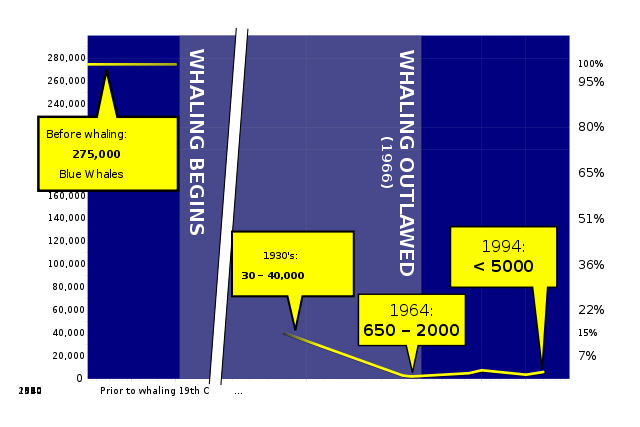
File:Blue Whale population, Pengo.svg

| |
This is a file from the Wikimedia Commons. Information from its description page there is shown below.
Commons is a freely licensed media file repository. You can help. |
Contents |
Caption
World population graph of Blue Whales ( Balaenoptera musculus).
Y-axis:
- Left axis shows world population estimate (the average is used when a range is given)
- Right axis shows the same values expressed as percentage of pre-whaling population
Data used
Based on data taken from animalinfo.org - Blue Whale and other sources.
(See below for expanded references)
| Year | Global population | Reference | Used |
|---|---|---|---|
| Before whaling | About 275,000 | (Kemf & Phillips 1994) | yes |
| 1935 | 100,000 | (Animal World 1972) | no |
| 1930s | 30,000 - 40,000 | (IUCN 1966) | yes |
| 1962 | 930 - 2790 | (IUCN 1966) | yes |
| 1964 | 650 - 2000 | (Oryx 1964a) | yes |
| 1970 | 600 | (Animal World 1972) | no |
| Late 1970s | 4000 - 4500 | (Burton & Pearson 1987) | yes |
| 1980 | About 6500 | (Nowak & Paradiso 1983) | yes |
| 1990 | 2500 - 3000 | (Klinowska 1991) | yes |
| 1994 | Probably under 5000 | (Kemf & Phillips 1994) | yes |
| 2002 | 5000 - 02 | (Pop 2002) | no |
Some data points were not used because I found them only after making the graph. Also (Animal World 1972) is a poor source, as it's an encyclopedia without citations.
References:
- Kemf & Phillips. 1994. Whales in the Wild. World Wildlife Fund, Gland, Switzerland.
- IUCN 1966 Red Data Book. Vol. 1 - Mammalia. International Union for the Conservation of Nature and Natural Resources, Morges, Switzerland.
- Oryx 1964a. Whaling agreement hitch. Oryx 7:145.
- Burton & Pearson. 1987. Rare Mammals of the World. Stephen Greene Press, Lexington, MA, USA.
- Nowak & Paradiso. 1983. Walker's Mammals of the World, vols. 1 and 2. 4th edition. Johns Hopkins University Press, Baltimore, MD, USA.
- Klinowska, M. 1991. Dolphins, Porpoises and Whales of the World - The IUCN Red Data Book. IUCN. Gland, Switzerland.
- Pop 2002 = Committee on the Status of Endangered Wildlife in Canada (2002) Assessment and Update Status Report on the Blue Whale Balaenoptera musculus Population size and trends, p5. (not used in this version of the graph)
- Animal World 1972 = Encyclopedia of the Animal World, 1972. p699 (not used in graph)
Notes
- Commercial exploitation of whales began in the 19th century.
- Average of estimates used rather than error bars.
- IUCN estimates may be only of mature individuals (need to check that).
- Prewhaling population may be a huge under-estimate. A recent study (2003) gives population estimates for fin and humpback whales far greater than those previously calculated for prewhaling populations. Similar studies have not yet been done for Blue Whales. (Roman, J and S.R. Palumbi. 2003. Whales Before Whaling in the North Atlantic. Science. 301: 508-510. PDF)
Tools
Made in OpenOffice Calc (v2.1), exported to SVG by first copying into Draw, and then practically recreated in Inkscape (v0.45). I don't recommend this way of making a graph.
Licensing
Image credit: Peter Halasz. ( User:Pengo)
| Public domainPublic domainfalsefalse |
 |
I, the copyright holder of this work, release this work into the public domain. This applies worldwide. In some countries this may not be legally possible; if so: I grant anyone the right to use this work for any purpose, without any conditions, unless such conditions are required by law. Public domainPublic domainfalsefalse |
If you wish to give attribution, please attribute image to:
- Peter Halasz
- and/or, link to this image page:
//commons.wikimedia.org/wiki/File:Blue_Whale_population,_Pengo.svg
derivative works
Derivative works of this file:
File usage
Metadata
Did you know...?
SOS Childrens Villages chose the best bits of Wikipedia to help you learn. SOS Children's Villages helps those who have nothing and no one, giving them back the famly they have lost and bringing them the very best opportunities for a happy, healthy future. Have you heard about child sponsorship? Learn more...
